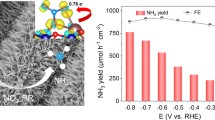The stage-by-stage mechanism of the reduction process proceeding in an acidic environment in the cathodic depolarization of ammonium sulfate (NH4)2SO4 (including the primary process such as synthesis of hydrogen peroxide H2O2 on a porous silver cathode by equation \( 2{\mathrm{H}}_2{\mathrm{O}}_2+2{\mathrm{S}\mathrm{O}}_4^{2-}=={\mathrm{S}}_2{\mathrm{O}}_8^{2-}+{\mathrm{O}}_2\uparrow +{\mathrm{H}}_2\mathrm{O} \) and the main final process such as \( 2{\mathrm{NH}}_4^{2+}+{\mathrm{S}}_2{\mathrm{O}}_8^{2-}=\left({\mathrm{NH}}_4\right){}_2{\mathrm{S}}_2{\mathrm{O}}_8\Big) \) along with the anodic reaction, \( 4{\mathrm{H}\mathrm{O}}_2^{-}=3{O}_2\uparrow +2{\mathrm{H}}_2\mathrm{O}+4\mathrm{e} \), on a platinum plate has been established. The silver cathodes were produced by powder metallurgy methods (compaction of silver nanopowder with particles 10–30 nm in diameter at 44.13 MPa followed by sintering of the samples in a purified hydrogen atmosphere at 450°C). The silver nanopowder was obtained as individual acicular nanocrystals that branched out and were held in pairs on the Pt plate in electrolysis in a 2% AgNO3 solution with addition of 1% nitric acid. The nanostate of the silver powder was verified with the BET method (Brunauer, Emmett, Teller) by low-temperature nitrogen adsorption. The ammonium persulfate synthesis kinetics and mechanism indicate that the replacement of commercial lead cathodes with oxygen-polarized silver cathodes leads to a 17.5% decrease in the electricity consumed. The polarization properties of the cellular silver cathode remain unchanged for 100 h of (NH4)2SO4 electrolysis.



Similar content being viewed by others
References
M.E. Pozin (ed.), Hydrogen Peroxide and Peroxide Compounds [in Russian], Moscow–Leningrad (1951), p. 478.
V.A. Rabinovich and Z.Ya. Khavin, Ammonium Persulfate: Concise Chemical Handbook [in Russian], 2nd ed., Leningrad (1978), p. 392.
V.P. Ilinskii and L.F. Sagaidachny, Production of Ammonium Persulfate in Electrolytic Oxidation in an Acidic Solution of Ammonium Sulfate in Electrolysis on Platinum Anode [in Russian], Moscow (2014), pp. 76–80.
V.I. Fedosiev and G.B. Sinarev, Introduction to Rocket Engineering [in Russian], Moscow (1956), p. 377.
O.Yu. Fedorova, “Effect of the concentration of ammonium persulfate produced on lead cathodes on the yield of environmentally friendly oxidants (hydrogen peroxide),” in: Collected Scientific Papers [in Russian], Tomsk Politech. Inst., Tomsk (2005), pp. 195–200.
O.I. Kudra and E.B. Gitman, Electrolytic Production of Fine Metallic Powders [in Russian], Kyiv (1952), p. 144.
O.I. Kudra, “On linear velocity of metal precipitation and formation of crystallization nuclei. 50 years of the Kyiv Polytechnic Institute,” in: Collected Scientific Papers [in Russian], Kyiv (1948), pp. 169–172.
M.W. Roberts and C.S. McKee, Chemistry of the Metal–Gas Interface, Oxford University Press, Oxford (1978).
J.H. de Boer, The Dynamic Character of Adsorption, Oxford University Press, Oxford (1953).
A. Traube and A. Solovyan, “Replacement of hydrogen ions discharge with the process of reestablishment,” Patent No. 126402-1934, Switzerland (1967), p. 4.
W.M. Latimer, The Oxidation States of the Elements and Their Potentials in Aqueous Solutions, Prentice-Hall (1952).
N.N. Voronin (ed.), R.Kh. Burshtein, and I.E. Veselovskaya, Collected Papers on Alkaline Elements of Air Depolarization [in Russian], Moscow (1947), p. 57.
N.N. Voronin and O.V. Izbekova, “Synthesis of peroxide compounds using powder metallurgy electrodes,” Ukr. Khim. Zh., 22, No. 1, 446–450 (1954).
S.I. Tkachenko and A.Yu. Khomenko, Determination of Specific Area of Porous Materials with BET and Aranovich Methods [in Russian], Moscow (2014), p. 47.
F.F. Volkenshtein, “Catalysts of chemical reactions,” Usp. Khim. Nauk, 60, No. 2, 247–252 (1956).
Author information
Authors and Affiliations
Corresponding author
Additional information
V. A. Lavrenko is deceased.
Translated from Poroshkova Metallurgiya, Vol. 57, Nos. 9–10 (523), pp. 124–136, 2018.
Rights and permissions
About this article
Cite this article
Lavrenko, V.A., Shchur, D.V., Zolotarenko, A. et al. Electrochemical Synthesis of Ammonium Persulfate (NH4)2S2O8 Using Oxygen-Depolarized Porous Silver Cathodes Produced by Powder Metallurgy Methods. Powder Metall Met Ceram 57, 596–604 (2019). https://doi.org/10.1007/s11106-019-00021-y
Received:
Published:
Issue Date:
DOI: https://doi.org/10.1007/s11106-019-00021-y




